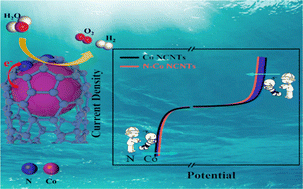Anion-induced electronic localization and polarized cobalt clusters for highly efficient water splitting†
Abstract
It is a promising pathway to use anions to regulate electronic structures, reasonably design and construct highly efficient catalysts for water splitting. Herein, a N-regulated Co cluster catalyst confined in carbon nanotubes, N-Co NCNTs, was constructed successfully. Nitrogen anions played a crucial role in optimizing the electronic structures of Co clusters and enhancing localization of electrons, resulting in polarized cobalt clusters. The N-induced electronic localization and the resulting polarized Co clusters are responsible for the improvement of catalytic activity. N-Co NCNTs exhibited ultra-low overpotentials of 178 mV and 92 mV for the OER and HER to achieve 10 mA cm−2 in an alkaline electrolyte, respectively. Its long-term catalytic durability is mainly attributed to the obstacle to the surface oxidation of Co clusters caused by N-regulation. N-Co NCNTs maintained a stable current density for 160 h at 10 mA cm−2. DFT computations confirmed the decisive role played by nitrogen anions in regulating the electronic structure. This work provides a pathway for understanding and designing highly efficient anion-regulated catalysts.



 Please wait while we load your content...
Please wait while we load your content...